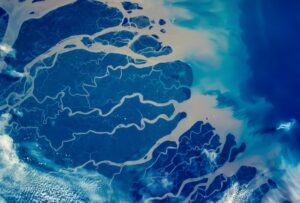The stellar weather continues for Antarctica’s man and woman haulers. Meanwhile, a very different expedition heads across the Drake Passage.
Longest Polar Expedition
Last week, Geoff Wilson abandoned part of his expedition because of concern over a fuel leak. Instead of going to the South Pole, he is heading directly to Dome Argus.
For five days, calm weather caused agonizingly slow progress for the kiter. On December 7, the wind picked up. Despite issues with his bindings and worrying cracks in one sled, he made better headway. He pushed hard when conditions allowed, clocking 192km on December 11.
The climb to the Dome, described by Wilson as “an icy Ayers Rock, but the top is 100km wide,” slowed to a crawl as he hit deep snow on the plateau. Coupled with an upwind tack, the final 150km to Kunlun station required manhauling. Occasionally, he had to shuttle each sled individually up the incline. At first, reluctant to manhaul — it’s discouragingly slow if you’re in a kiting mindset — he “faffed around”, trying to harness small gusts of wind. But after bagging only a miserly two kilometres in five hours, he accepted defeat.
But luck was on Wilson’s side. On December 14, the wind returned, and he was able to complete the remaining 120km to the Dome in one glorious day. He made sure to climb to the ridgetop behind the (currently) uninhabited station, thus becoming the first person to reach the Dome solo and unsupported.
Now, the long journey home begins.

Wilson celebrates at Dome A. Photo: Geoff Wilson
Women’s Speed Record Attempts
The two speed record hopefuls remain mum on their exact distances, but both seem to be on track to reach the Pole in less than 39 days.
Wendy Searle recently saw signs of life for the first time in two weeks. First, she came across some fresh ski tracks on day 17. She absentmindedly followed them for a while before realizing that they weaved haphazardly through the sastrugi and were slowing her down! Five days later, a plane passed overhead, on its way to the Pole. After three weeks, her progress remains on pace to best Johanna Davidsson’s South Pole speed record.

Ski tracks spotted by Searle. Photo: Wnedy Searle
Jenny Davis has only posted one brief update in the last week. She’s “doing well” and over halfway, which keeps her within striking distance of the record, too.
Solos to the South Pole
Thanks to the great weather and hard snow — a total reversal from last year — everyone is making good progress toward the Pole.
Mollie Hughes is halfway there. By December 17, she had covered 300 nautical miles (555km) — and passed her fifth degree — on the way to 90ºS. She also managed to vote by proxy in the UK election, surely the most remote proxy vote ever cast.
Neil Hunter continues to increase his daily distance and seems to have sorted out his route-finding problems from last week. He is further back than Hughes, having just crossed 84ºS.

Sunshine, calm, hard snow: a polar trekker can’t ask for more. Photo: Wendy Searle
The Thiel Mountains were a welcome sight for Jacek Libucha. He passed the halfway point on December 13 and has been managing his Achilles pain with liberal doses of ibuprofen and paracetamol. He is still worried about food because of his cautious pace and because of the early storms that caused him to eat more of his supplies than his progress justified.
On December 16, Anja Blacha crossed her own halfway point at 700km. She started at the true coast and so is covering a considerably longer distance.
Guided Efforts of Note
Jing Feng, Sarah McNair-Landry and Erik Boomer have continued to churn out long days and have taken their daily average north of 30km. On December 18, they picked up their latest fuel cache.
Robert Swan and company completed the first third of their journey from Thiels Corner on December 16. They are still climbing towards the Pole.

Robert Swan with his favorite expedition food, beef stew. Photo: Robert Swan
There was an unscheduled rest day for Lucy Reynolds on December 15. The group’s guide was feeling under the weather, and with “an abundance of caution”, they decided it would be best to devote a day to recovery. Despite the unplanned stop, they are making good progress, approaching 84ºS.
Drake Passage Row
After Colin O’Brady’s “impossible first” last year that turned out not be impossible and debatably wasn’t a first, it’s the “impossible row” next. He joins a team of six (O’Brady, Jamie Douglas-Hamilton, John Petersen, Andrew Towne, Cameron Bellamy and captain Fiann Paul) set out six days ago to row across the Drake Passage to Antarctica.

A passing cruise ship checks out O’Brady and his team. Photo: Colin O’Brady
As with O’Brady’s Antarctica crossing, it is important to note that there are semantic acrobatics going on here. Though O’Brady bills his expedition as “the first completely human-powered ocean row across the Drake Passage”, the journey has been done before. In 1988, legendary adventurer Ned Gillette completed the crossing in the Sea Tomato, a 28-foot aluminium boat that Gillette built himself. Perhaps the presence of a small sail on the Sea Tomato (used for navigating along the coasts at either end of the crossing) has been enough for O’Brady to discount this as completely human-powered?
The team have made a strong start, covering 284 nautical miles (526km) from Chile in the first six days.






